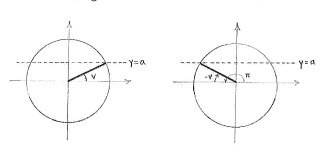Lösung 4.3:3b
Aus Online Mathematik Brückenkurs 1
(Unterschied zwischen Versionen)
K |
|||
| Zeile 1: | Zeile 1: | ||
| - | The angle | + | The angle <math>\pi-v</math> makes the same angle with the negative ''x''-axis as the angle <math>v</math> makes with the positive ''x''-axis and this means that <math>\pi-v</math> is the reflection of <math>v</math> in the ''y''-axis. |
| - | <math>\pi -v | + | |
| - | makes the same angle with the negative | + | |
| - | + | ||
| - | -axis as the angle | + | |
| - | <math>v</math> | + | |
| - | makes with the positive | + | |
| - | + | ||
| - | -axis and this means that | + | |
| - | <math>\pi -v | + | |
| - | is the reflection of | + | |
| - | <math>v</math> | + | |
| - | in the y-axis. | + | |
[[Image:4_3_3_b.gif|center]] | [[Image:4_3_3_b.gif|center]] | ||
| - | Under such reflection, the angle's | + | Under such reflection, the angle's ''y''-coordinate does not change (but the ''x''-coordinate changes sign) and therefore <math>\sin (\pi-v) = \sin v = a\,</math>. |
| - | + | ||
| - | -coordinate does not change (but the | + | |
| - | + | ||
| - | -coordinate changes sign) and therefore | + | |
| - | <math>\ | + | |
Version vom 13:23, 9. Okt. 2008
The angle \displaystyle \pi-v makes the same angle with the negative x-axis as the angle \displaystyle v makes with the positive x-axis and this means that \displaystyle \pi-v is the reflection of \displaystyle v in the y-axis.
Under such reflection, the angle's y-coordinate does not change (but the x-coordinate changes sign) and therefore \displaystyle \sin (\pi-v) = \sin v = a\,.

